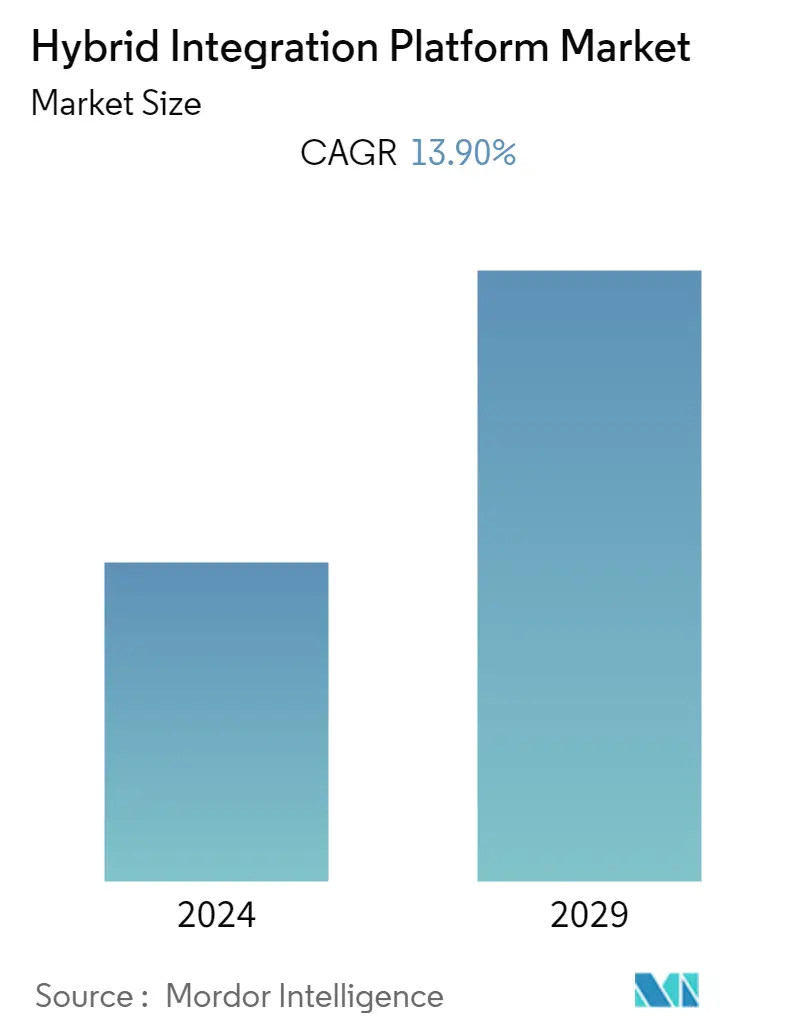Market Size of Hybrid Integration Platform Industry

| Study Period | 2019 - 2029 |
| Base Year For Estimation | 2023 |
| CAGR | 13.90 % |
| Fastest Growing Market | Asia-Pacific |
| Largest Market | North America |
| Market Concentration | Low |
Major Players
*Disclaimer: Major Players sorted in no particular order |
Need a report that reflects how COVID-19 has impacted this market and its growth?
Hybrid Integration Platform Market Analysis
The hybrid integration platform market is expected to register a CAGR of 13.9 percent during the forecast period. Hybrid integration platforms drive digital transformation in industries. The mere deployment of the cloud in operations cannot make businesses fully leverage it to optimize their operations. One of the major roadblocks that frequently comes up in cloud adoption is the integration of cloud and on-premise applications. Because of this, organizations need help with problems like latency in their operations, which leads to missed deadlines, dissatisfied customers, and many more unresolved issues. A hybrid integration platform ensures the seamless integration of various business applications and a secure gateway for data transactions across different hosting environments.
- The demand for hybrid cloud in recent years has gained traction, as has the need for hybrid integration platforms for its successful deployment. The cost savings and scalability achieved by the successful deployment of hybrid clouds have increased the competencies of organizations across industries. So, the other companies in the industry also plan to use this to expand the use of the technology.
- Hybrid integration platforms connect the network between enterprises, customers, and suppliers via BYOD (enterprise mobile) and big data, allowing on-premises applications to integrate with cloud-based applications. As a result, hybrid integration platform adoption is increasing. Another important element driving demand for hybrid integration platforms is the growing need for cloud-based apps, data, and services.
- The increasing deployment of cloud-based solutions across various sectors to maximize industrial digitalization is a significant driving factor for the growth of the industrial hybrid integration platform market throughout the forecast period. Various governments throughout the globe are investing heavily in digitalization to improve job efficiency and flexibility. Many companies are concerned about interoperability across different cloud environments and data security. This security need drives the demand for hybrid integration platforms.
- However, the high risks associated with open-source integration and interoperability are considered major restraints for adopting hybrid integration platforms. The demand for hybrid cloud solutions and services has increased as the enterprise environment has evolved. Organizations are currently facing the challenges of utilizing big data in their databases for competitive advantage. It has pushed enterprises to adapt to hybrid cloud services. Some end users, such as BFSI and healthcare, choose hybrid services instead of completely switching to the cloud. Such adoption measures have created an opportunity for the hybrid integration platform in the market.
During the COVID-19 pandemic, deploying virtual solutions for treating and managing patients was analyzed as a significant driving factor for the growth of the hybrid integration platform in the healthcare sector. After the pandemic, the market grew significantly with increased digitization among various end users. The hybrid cloud provided essential features like high availability, scalability, business continuity, fault tolerance, disaster recovery, automatic software updates, flexibility, etc. With the growing interest in cloud adoption by various enterprises, many new features and services have emerged over time.
